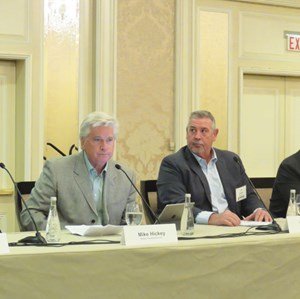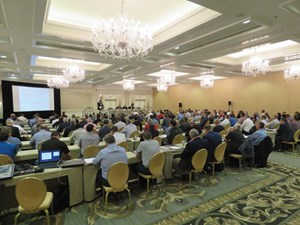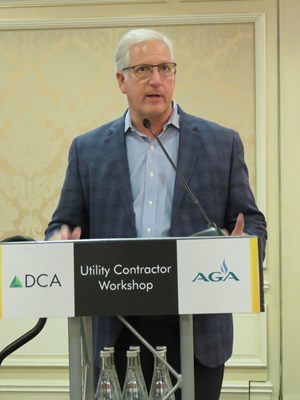July 2019 Vol.74 No. 7
Features
DCA-AGA Workshop Discusses Industry Issues, Successes
Eben Wyman | DCA Government Liaison
On April 22–24, the Distribution Contractors Association (DCA) and the American Gas Association (AGA), held the 6th Annual DCA/CGA Workshop in Chicago. The workshops are intended to increase communication and cooperation between local distribution companies (LDCs) and the contractors who build gas distribution infrastructure for them.
These events reflect the strong relationship between DCA and AGA, and this year’s workshop addressed a range of high-profile issues at a time when policymakers were beginning to focus on pipeline safety, and the distribution sector was receiving significant attention.
Merrimack Valley
In September 2018, a series of explosions and fires occurred after a gas distribution system released high-pressure natural gas into a low-pressure system in Merrimack Valley, Mass. While this incident presented several challenges facing the gas distribution industry just months before Congress began the next reauthorization of the nation’s pipeline safety program, the industry response provides an ideal example of how pipeline operators and contractors work together in an emergency.
The Merrimack Valley incident began as a replacement project of 1,100 miles of pipe, where the LDC was replacing a cast-iron main with a plastic distribution main. The iron pipe being replaced had regulator-sensing lines used to detect pressure in the distribution system. When the cast iron main was disconnected, the section containing the regulator-sensing lines began losing pressure. As pressure dropped, regulators opened up, increasing pressure in the distribution system, which then started failing and resulted in leaks and explosions. There was one fatality and destruction of several homes.
The panel discussing the follow-up to the incident consisted of representatives from Miller Pipeline and InfraSource, two construction companies that were front and center in the response to this incident. According to these contractors, the response and preparation by the LDC was as effective as it could be. Through close cooperation, the utility and participating contractors were able to mobilize and “onboard” approximately 200 new crews in about 10 days.
Crews were housed; and resource planning, permitting and change approval processes were accelerated to enable 50 miles of pipe to be replaced in 50 days – with no recordable OSHA incidents – underscoring exemplary cooperation between an LDC and contractor crews.
The panel spent a good amount of time discussing the onboarding process. Obviously ensuring workers had the qualifications needed to perform the work was critical, and LDC representatives could not have been better prepared to put new crews to work, according to these contractors. Interaction with unions also came into play, and through cooperation and communication, seemingly countless man-hours of work were performed without incident, and downtime was cut in half.
While unfortunate, this incident clearly provided an example of “how to” respond and underscores a success story in terms
of mutual aid.
Pipeline Safety Management Systems
Pipeline Safety Managements Systems (SMS) has been a main focus in the halls of the U.S. Department of Transportation’s (DOT) Pipeline and Hazardous Materials Safety Administration (PHMSA) for the past several years, and industry is responding to calls to embrace SMS in pipeline operations and construction. A panel of representatives consisting of a DCA contractor, the AGA point person on SMS and representatives of ENERGY worldnet provided a thorough discussion of this subject.
SMS is often misunderstood as to what it is, what it isn’t, what is required and how to get started. Instead of a typical presentation on SMS, this panel provided perspective from a contractor in the process of implementing SMS, AGA’s insight on how LDCs are moving toward the cyclical SMS approach, and what can be expected from federal and state regulators in terms of voluntary transition, versus policy mandating SMS in the pipeline industry.
While PHMSA has reiterated that the agency has no immediate plans to regulate SMS, it’s clear that there is “encouragement” of adopting SMS and many in the industry are preparing for possible mandates. Therefore, associations representing pipeline contractors have embraced the American Petroleum Institute’s (API) Recommended Practice 1173. AGA has nine working committees looking at SMS and effective approaches to implementing a culture of safety in LDC operations.
Some contractors recognize that they must catch up with operators in terms of SMS implementation, and that maintaining elaborate safety programs is not equivalent to having SMS in place. However, the concept of buy-in from senior management is already in place with most contracting companies. Data is needed and conducting a gap analysis will facilitate a transition to SMS, but many SMS concepts are already embraced by gas distribution contractors. Gap analyses comparing existing safety operations to maintaining and SMS, as well as further understanding of the “plan-do-check-act” process will help the contracting community move toward implementation of SMS.
A representative of ENERGY worldnet, who previously served as chair of the National Association of Pipeline Safety Representatives (NAPSR), provided valuable insight about what may be expected from state pipeline inspectors. While NAPSR does not currently have a position on SMS, there is a wide range of opinions on the subject in states across the country, and some inspectors are pushing SMS concepts in enforcement actions.
The Merrimack Valley incident will likely drive SMS implementation in the gas distribution industry, and there is already legislation introduced by Democratic Sens. Ed Markey and Elizabeth Warren of Massachusetts that would mandate SMS concepts in the next pipeline safety reauthorization process. In addition, the DOT’s Office of Inspector General is now moving toward ensuring that PHMSA includes a “safety culture” in its own operations, further highlighting pressure on PHMSA to focus of SMS.
The concept of maintaining an open-door policy for allowing contractors to point out safety issues was reiterated, and the true fundamentals of needing buy-in from senior management and striving for continuous improvement were main themes covered by this panel. Additionally, DCA is in the process of developing a template for contractors to reference when implementing or improving existing SMS programs. The template is being reviewed and feedback is being collected by two other leading associations in the pipeline construction industry. The goal is to gain approval by contractor groups, and present the template to government and industry organizations to demonstrate that the pipeline construction industry embraces SMS concepts.
Broadband and damage prevention
As policymakers in Washington continue to talk about the need for an “infrastructure package,” the issue of broadband deployment, especially in rural areas, is continually brought up early in the discussion. Broadband providers across the country are increasingly initiating projects, and federal programs are providing resources to deploy fiber broadband infrastructure.
As with any construction project to implement underground infrastructure, the need for shared responsibility in preventing underground damages is critical. The DCA/AGA Workshop featured a panel consisting of a broadband contractor, telecom carriers and underground facility locators to discuss the challenges that accompany robust fiber deployment schedules and how all these stakeholders can better work together to protect underground facilities.
The broadband contractor set the stage for this discussion by making it clear that all players in this discussion have a job to do, and that there are high-quality contractors, carriers and locators and others who need to do a better job in meeting their responsibilities. All panelists agreed that for the most part, association members are high performers, and that the goal should be to “go after the cowboys” who cut corners and put people and underground facilities at risk.
Panelists also agreed that workforce capacity issues continue to challenge the industry. Contractor locators, as well as excavators, continue to struggle with meeting demand, and the high rate of buildouts of fiber optic systems will not likely slow down anytime soon. It was also noted that the damage prevention process is fundamental to constructing all underground infrastructure, including broadband, natural gas, water and sewer, and other underground systems.
Several contractor organizations are pushing the importance of what they refer to as the “Three Pillars” of damage prevention, including:
- Mandatory participation in One-call (notification and membership)
- Accurate and timely locating and marking of facilities
- Potholing by contractors
Panelists also encouraged participation in state and local damage prevention counsels, such as the “Regional Partners” program overseen by the Common Ground Alliance (CGA).
Importantly, the panelist representing broadband carriers underscored the need for underground facility owners to include compensation for potholing. It was also noted that local ordinances that restrict “breaking pavement” compromise damage prevention. These are fundamental points that need to be addressed in the bidding process and in discussions about local damage prevention laws and ordinances.

Technological advancements
Modern “technologies and industry practices in the gas distribution are ever-emerging,” according to a representative from the Gas Technology Institute (GTI), who presented new information on keyhole technologies related to pavement coring and vacuum excavation used by both LDCs and their contractors. These technologies support a range of utility construction projects, especially in urban settings. According to GTI, both operators and contractors are jointly deploying technology to automate data collection during construction. GTI is also working on issues related to plastic pipe systems, such as fusion processes and efforts to locating plastic pipe.
Geospatial underground mapping technology is providing higher accuracy of the location of underground assets. A representative from Condux International discussed modern technologies and methods used to enhance damage prevention efforts and cooperation among utility operators and contractors. This technology can be effective in not only the gas distribution market, but also on water/sewer and broadband/telecommunications projects. The primary objective for this mapping tool is to obtain the general shape of a buried facility (identification of straight sections, curves, etc.) and an optional software module will be offered to obtain additional data.
Panelists also addressed technologies to enhance excavation damage prevention, such as encroachment detection and GIS mapping technology to provide key data in “real time.” An LDC representative focused on technological advancements in asset data capturing that may facilitate compliance with tracking and traceability requirements included in a recent PHMSA rulemaking on plastic pipe.
HDD outreach, education
A large panel of field engineers working for gas operators and contractors, as well as representatives of equipment manufacturers and a federal agency, provided an update of growing efforts to educate and promote the use of horizontal directional drilling (HDD).
DCA now has two committees working jointly on both education and advocacy efforts. DCA’s Government Relations committee has already visited with several federal agencies, such as the Environmental Protection Agency and the Federal Energy Regulatory Commission, and industry organizations, some of which might be considered “unfriendly” audiences when it comes to HDD.
A prime example is the BlueGreen Alliance, a group of leading environmental organizations and large unions working cooperatively on efforts that promote both job creation and sound environmental policy. While brief and preliminary, these discussions made some progress in educating part of the environmental community about the benefits of HDD and misconceptions about trenchless installations.
DCA is also developing an HDD flyer that provides general information on trenchless technology installations, including descriptions of trenchless equipment, boring fluids and related additives, and the many advantages of HDD.
DCA is working with NiSource on HDD education at the state level and facilitated development of the operator’s HDD Guidelines, which states, “NiSource believes that Horizontal Directional Drilling (HDD) is a safe and environmentally friendly means of installing utilities, if it is done correctly. NiSource proposes that Pennsylvania HDD policy should recognize HDD limitations and promote best practices to mitigate the potential environmental impact of those limitations.
“Pennsylvania should require the use of best practices for HDD operations for HDDs beneath wetlands, streams, or waterbodies. Pennsylvania should also consider some minimal environmental impact acceptable for well-planned and -executed HDDs that may result in Inadvertent Returns (IRs) because of unanticipated conditions.”
This panel covered a range of issues, including robust discussion of existing knowledge and perceptions about HDD, how engineers, contractors and operators can better communicate during all stages of an HDD process, and best ways to prevent and mitigate IRs.
Market overview
Workshop attendees were provided a comprehensive and informative overview of the gas distribution market and other economic analysis by Continuum Capital. The presentation included a general economic synopsis, political and regulatory perspectives, the transformation of several utility markets, and perspectives regarding market performance.
The past few years have been exceptional for the American economy, with great optimism in general, but especially in the construction industry. However, the “political environment is poisoned,” and the likelihood of any legislation is reduced by a potentially volatile presidential election year in 2020.
Continuum Capital also provided market comparisons, indicating that while the global economy may be slowing, the picture for domestic economy continues to grow. However, the entire construction industry must continue to address workforce capacity challenges. While an estimated 80-to-90 percent of construction is currently done by contractors, the struggle to recruit and retain construction workers continues to present the industry’s biggest challenge.
OQ pilot program
The Operator Qualification Integrity Coalition is comprised of contractors, gas associations, OQ service providers and industry experts who are pilot testing a new process intended to increase the integrity of OQ programs through consistency and standardization of OQ elements. The coalition has completed a guidance document for participants in the OQ Integrity Process (OQIP) and is in the process of launching a pilot program with operators, contractors, OQ providers and state regulatory representatives in three states.
Coalition members provided a history and evolution of OQIP, where the underlying reason for establishing the coalition was to increase the “portability” of contractors’ OQ programs, but progressed to focus on enhancing the integrity of the entire OQ process.
The panel ran through main elements of the OQIP, including:
- People: trainers, proctors, evaluators and auditors (each with criteria and credentialing requirements)
- Process: development of core competencies (based on ASME B31Q Standard), training curriculum, testing methodology (and security), management of change controls
- Program Validation: internal self-audit and review of program effectiveness, recordkeeping and documentation
The pilot program will test whether an OQIP approach can raise the bar while increasing consistency and providing a set of standardized processes. If successful, the OQIP will provide a standardized, credible and valid process of increasing integrity in OQ, and will increase OQ compliance and transferability, as well as:
- Improved pipeline safety
- Enhanced regulatory confidence
- Continuous improvement & program effectiveness
- Increased accountability & transparency
- Risk reduction of incorrect operations
- Workforce development & utilization
It was noted that OQIP addresses many issues covered during discussion of effective SMS programs, and that the progression toward the “OQ Integrity Process is a marathon, not a sprint.”
Mutual Aid
The issue of mutual aid is a hot topic right now, and the audience was reminded of the success story discussed previously in the panel on the Merrimack Valley incident. Two contractors and an LDC representative provided their experiences with mutual aid efforts, including planning and reaction to incidents involving both natural gas and electric infrastructure. Discussion also addressed logistical challenges, key elements to effective execution, and collaboration between utilities and contractors involved in mutual aid.
A contractor based in New York discussed two other high-profile examples of successful mutual aid in the wake of both Hurricane Sandy and the terrorist attacks in New York City on Sept. 11, 2001. Because incidents that require a mutual response vary significantly, many times “there’s not really any way to prepare,” according to a contractor serving on the panel. The LDC panelist indicated that utilities have broad preparations that can be made in cases that require mutual aid, but agreed that there are certainly “unexpected situations,” where flexibility and the need to be nimble come into play.
A contractor suggested that “command posts” must be set up where clear direction and two-way communication is provided. Appropriate onboarding processes are critical, covering all safety issues and, in the case of natural gas, operator qualifications must be confirmed. The panel agreed that “listening to the contractor” throughout the response will make for more effective mutual aid.
Challenges related to workforce capacity also impact mutual aid efforts. Additionally, ensuring all documentation/recordkeeping is maintained on issues related to span or control along with clear communication methods will result in effective mutual aid efforts. •






Comments